Topic: DATA PRESENTATION, MEASUREMENTS, and FORCE
Hello Students! Watch this video and get an overview of how the physics world works!
Physics involves observing and measuring the world around us. Once we have measurements (data), we need good ways to show that information so it's easy to understand. Then we'll learn about base units and derived units, and finally, we'll study pressure – what it is and how it works, especially in liquids and gases.
Sub-Topic 1: DATA PRESENTATION
Imagine you have collected some numbers from an experiment or survey. Just listing numbers can be confusing. Charts and graphs help us see patterns and understand the information quickly.
A. Pie Charts (Machati akaita sePizza so)
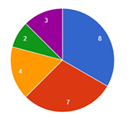
- What it is: A pie chart is a circle divided into slices (like slicing a cake or a pie). The whole circle represents the total amount (100%) of something, and each slice shows a part or percentage of that total.
- When to use it: Best used to show how a whole thing is divided into different parts or categories (e.g., types of crops grown on a farm, different tribes in a class, how someone spends their money).
- Constructing a Pie Chart (How to Draw):
- Find the Total: Add up all the parts to get the whole amount.
- Calculate Percentage or Fraction: Figure out what fraction or percentage each part is of the total.
- Calculate the Angle: A full circle has 360 degrees (360°). To find the angle for each slice, multiply its fraction (or percentage) by 360°.
Angle = (Part / Total) × 360° - Draw the Circle: Use a compass to draw a neat circle.
- Draw the Slices: Use a protractor to measure and draw the angle for each slice, starting from a line drawn from the centre to the top.
- Label: Clearly label each slice with what it represents and often its percentage or value. Give the chart a title.
- Interpreting a Pie Chart (Reading):
- Look at the size of the slices. The biggest slice represents the largest part of the whole.
- Compare the slices: Which part is bigger? Which is smaller? Are any parts roughly equal?
- Read the labels and percentages to know the exact values.
- Analysing a Pie Chart (Understanding):
- What does the chart tell you overall? Which category is dominant?
- How do the different parts relate to each other in terms of size or proportion?
- Can you make conclusions based on the proportions shown? (e.g., "Most of the money was spent on food").
B. Line Graphs (Magirafu eLine)
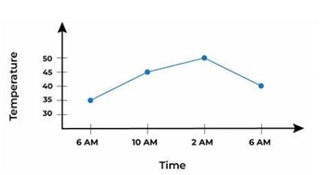
- What it is: A line graph uses points connected by lines to show how something changes over time or in relation to another changing quantity.
- When to use it: Best used to show trends, increases, decreases, or steady values over a period (e.g., temperature changes during the day, growth of a plant over weeks, speed of a car during a journey).
- Constructing a Line Graph (How to Draw):
- Draw Axes: Draw two lines at right angles. The horizontal line (bottom) is the X-axis. The vertical line (side) is the Y-axis.
- Label Axes: Label the X-axis with the independent variable (what you control or what changes steadily, usually time). Label the Y-axis with the dependent variable (what you are measuring). Include units (e.g., Time (hours), Temperature (°C)).
- Choose Scales: Choose suitable scales for both axes so your data fits neatly on the graph. The numbers should increase evenly along each axis.
- Plot Points: For each pair of data values, find the value on the X-axis and the corresponding value on the Y-axis. Mark the point where these meet on the graph (use a small 'x' or dot).
- Draw the Line: Connect the points in order using straight lines drawn with a ruler. (Sometimes a smooth curve might be appropriate if the change is expected to be smooth).
- Add Title: Give the graph a clear title explaining what it shows.
- Interpreting a Line Graph (Reading):
- Read values: You can find the value on the Y-axis for any given point on the X-axis, and vice versa.
- Look at the line's direction:
- Sloping Up: Shows an increase.
- Sloping Down: Shows a decrease.
- Horizontal: Shows no change (steady value).
- Look at the line's steepness: A steeper slope means a faster change.
- Analysing a Line Graph (Understanding):
- Describe the trend: What is happening overall? Is it increasing, decreasing, staying the same, or fluctuating?
- Identify key points: Where is the highest value? Lowest value? Where is the change fastest? Slowest?
- Explain the trend: Can you suggest reasons for the changes shown?
Sub-Topic 2: MEASUREMENTS
Physics relies on accurate measurements. We use standard units.
- Base Units: These are the fundamental units that other units are built from. The main ones we use are:
- Length: metre (m)
- Mass: kilogram (kg)
- Time: second (s)
- Electric Current: ampere (A)
- Temperature: kelvin (K) (though Celsius °C is often used)
- Derived Quantities & Units: These are quantities calculated using combinations of base units.
Expressing Derived Quantities in Base Units:
(kana ukanzi isa ku base unit unotnga wanyora formula for example Area= Length x Width…wadaro womyora kut length ino mhezhiwa in meters yakamirirwa na m then woisa X then woona kuti width ino mhezhiwa in meters, meters yakamirirwa na m . Unobva wasara na m x m . ku maths m x m hanty ndi m². Gives us our final answer kut base unit ye area ndi m² inosheedzwa ichinzi skwee mitas)
You figure this out by looking at the formula for the derived quantity.
- Area: Formula = Length × Width
- Base Units: m × m = m² (square metres)
- Volume: Formula = Length × Width × Height
- Base Units: m × m × m = m³ (cubic metres)
- Speed: Formula = Distance / Time
- Base Units: m / s = m/s or ms⁻¹ (metres per second)
- Acceleration: Formula = Change in Speed / Time
- Base Units: (m/s) / s = m/s² or ms⁻² (metres per second squared)
- Density: Formula = Mass / Volume
- Base Units: kg / m³ = kg/m³ or kg m⁻³ (kilograms per cubic metre)
- Force: Formula = Mass × Acceleration (Newton's 2nd Law)
- Base Units: kg × (m/s²) = kg m/s² or kg m s⁻² (This combination is also called a Newton, N)
- Pressure: Formula = Force / Area
- Base Units: (kg m/s²) / m² = kg / (m s²) = kg m⁻¹ s⁻² (This combination is also called a Pascal, Pa)
Sub-Topic 3: FORCE & PRESSURE

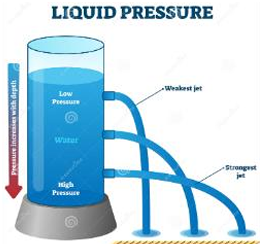
A. Defining Pressure:
- Force (Simba) is a push or a pull.
- Pressure is about how concentrated that force is.
- Definition: Pressure is the Force acting perpendicularly (straight on) on a unit Area.
- Imagine pushing a drawing pin (thumb tack) into wood. You apply a force with your thumb. The sharp point has a tiny area, so the pressure is very high, pushing the pin in easily. If you pushed with the same force on the flat head, the area is large, the pressure is low, and it won't go in.
- Pressure = Force / Area
B. Calculating Pressure:
- Formula: P = F / A
- P = Pressure
- F = Force (measured in Newtons, N)
- A = Area (measured in square metres, m²)
- Units: The standard unit of pressure is the Pascal (Pa).
- 1 Pascal = 1 Newton per square metre (1 Pa = 1 N/m²)
- Example Calculation: A box weighs 50 N (this is the force due to gravity). The bottom of the box has an area of 0.2 m². What pressure does it exert on the floor?
- P = F / A
- P = 50 N / 0.2 m²
- P = 250 N/m² = 250 Pa
C. Pressure in Fluids (Liquids and Gases):
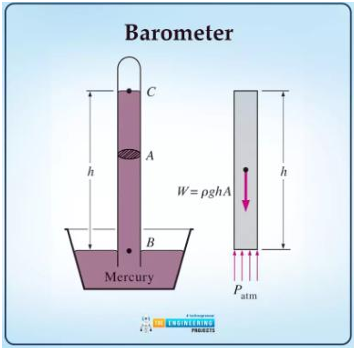

- Fluids (liquids and gases) also exert pressure. This pressure comes from the weight of the fluid above.
- Formula for pressure due to a fluid column: P = h ρ g
- P = Pressure (in Pa)
- h = height or depth of the fluid column (in metres, m)
- ρ = density of the fluid (rho - looks like 'p') (in kg/m³)
- g = acceleration due to gravity (approx. 9.8 or 10 m/s² on Earth)
- Example Calculation: What is the pressure at the bottom of a swimming pool 2 metres deep? (Density of water ≈ 1000 kg/m³, g ≈ 10 m/s²)
- P = h ρ g
- P = 2 m × 1000 kg/m³ × 10 m/s²
- P = 20 000 Pa (or 20 kPa - kilopascals)
D. Effect of Depth on Pressure:
- From the formula P = hρg, you can see that pressure (P) is directly proportional to depth (h).
- The deeper you go into a fluid, the greater the pressure.
- Why? Because there is more fluid above you, weighing down on you. This is why swimmers feel more pressure on their ears when they dive deep (kudzika) in a pool or dam.
E. Atmospheric Pressure:
- We live at the bottom of an "ocean" of air called the atmosphere. Air has mass and weight.
- Atmospheric Pressure is the pressure exerted by the weight of the air in the atmosphere above us.
- It presses on us from all directions. We don't usually feel it because the pressure inside our bodies balances the pressure outside.
- Changes in atmospheric pressure happen with altitude (less air above you on a high mountain = lower pressure) and weather conditions.
- We sometimes notice changes, like our ears "popping" when going up or down a mountain quickly, or in an airplane.
F. Simple Manometer (Measuring Gas Pressure):
- What it is: A manometer is a U-shaped glass tube containing a liquid (usually mercury or water).
- Purpose: Used to measure the difference between the pressure of a gas and atmospheric pressure, or the difference between two gas pressures.
- Construction: A glass tube bent into a U-shape, partly filled with a liquid. One end is connected to the gas supply being measured, the other end is often open to the atmosphere.
- How it Works:
- If the gas pressure is the same as atmospheric pressure, the liquid levels in both arms of the U-tube are equal.
- If the gas pressure is higher than atmospheric pressure, it pushes the liquid down in the arm connected to the gas, and up in the arm open to the atmosphere.
- If the gas pressure is lower than atmospheric pressure, the atmosphere pushes the liquid down in the open arm and up in the arm connected to the gas.
- Measurement: The difference in height (h) between the liquid levels in the two arms indicates the pressure difference. You can calculate the pressure difference using P = hρg (where h is the height difference, ρ is the density of the liquid in the manometer). The gas pressure is then Atmospheric Pressure +/– Pressure Difference.
G. Simple Fluid Systems (Using Pressure):
- Fluid systems use the pressure in liquids (hydraulics) or gases (pneumatics) to transmit force and do work.
- Key Principle (Pascal's Principle): Pressure applied to an enclosed fluid is transmitted equally throughout the fluid.
- Operation Example (Hydraulic Brakes/Jack):
- A small force is applied to a small piston (small area) in contact with a liquid (like brake fluid).
- This creates a pressure (P = F/A) in the liquid.
- This pressure is transmitted equally through the liquid to a larger piston (large area).
- Because Pressure = Force / Area, the Force on the larger piston (F = P × A) is much greater than the initial force applied.
- This allows a small effort (e.g., pressing the brake pedal) to create a large force (e.g., pressing the brake pads against the wheel).
H. Simple Pumps (Moving Fluids):

Pumps are devices used to move fluids (liquids or gases) from one place to another, often against pressure or gravity. They use pressure differences created by moving parts.
1. Lift Pump (e.g., Blair Pump - common hand pump for water):
- Structure: A cylinder with a piston inside. The piston has a valve that opens upwards. There is another valve at the bottom of the cylinder that also opens upwards. An outlet pipe (spout) is above the bottom valve.
- Function: To lift water from a source (like a well) to the outlet.
- Operation:
- Upstroke: Piston moves up. Bottom valve opens, allowing water to be drawn into the cylinder below the piston (due to reduced pressure). Piston valve stays closed due to water weight above it.
- Downstroke: Piston moves down. Bottom valve closes (pushed shut by water pressure). Pressure below the piston increases, forcing the piston valve open. Water moves from below the piston to above the piston.
- Next Upstroke: Piston moves up, lifting the water above it towards the spout. At the same time, more water is drawn into the cylinder through the open bottom valve.
- The Blair pump is a type of lift pump designed for reliability and easy maintenance in rural settings.
2. Force Pump (e.g., Bicycle Pump):
- Structure: A cylinder with a piston. The piston usually has a flexible seal (like leather or rubber) that acts like a valve (seals on downstroke, lets air pass on upstroke). There is an outlet valve at the bottom connected to the hose.
- Function: To force air (a gas) into something against pressure (like a bicycle tyre).
- Operation:
- Upstroke: Piston moves up. The seal on the piston allows air from outside to pass around it and fill the cylinder below the piston. The outlet valve stays closed (pressure outside is higher).
- Downstroke: Piston moves down. The flexible seal spreads out and seals against the cylinder wall. Air below the piston is compressed (pressure increases). This high pressure forces the outlet valve open, and air is pushed out through the hose into the tyre.
- It doesn't just lift the air, it forces it out under pressure.

Let's Summarise: Data, Measurements & Force
- Pie charts show parts of a whole; Line graphs show changes over time. Both help visualize data.
- Derived units (like m/s for speed, kg/m³ for density) are combinations of base units (m, kg, s, etc.).
- Pressure is Force per unit Area (P=F/A). Units are Pascals (Pa).
- Fluid pressure increases with depth (P=hρg).
- Atmospheric pressure is the pressure from the weight of air above us.
- A manometer measures gas pressure differences using liquid height.
- Fluid systems (hydraulics) use pressure to multiply force.
- Pumps (Lift pump, Force pump) use moving pistons and valves to move fluids by creating pressure differences.
Topic: ENERGY - Solar Power Applications
Hello Students!
The sun gives us a huge amount of energy every day in the form of light and heat. We can design special equipment to capture this energy and use it. Today we will look at two examples: the Solar Cooker and the Solar Water Heater.
Solar Cooker (Chibikiro cheSolar)

A. Function (Basa Rayo / What it Does):
- The main function of a solar cooker is to use sunlight energy directly to cook food or boil water.
- It replaces the need for fire (moto) from firewood or charcoal, or using electricity or gas stoves.
- It works by trapping the sun's heat and concentrating it onto a cooking pot.
B. Design (Magadzirirwo Acho / How it is Made):
There are different designs, but most use these main ideas:
- Concentration (Kuunganidza heat):
- Design: Uses shiny, reflective surfaces (like mirrors, aluminium foil - foiri rinopenya) arranged in a curve or as panels around a central area.
- How it Works: These surfaces bounce the incoming sunlight and direct it towards one spot – where the cooking pot (hari yekubikira) will be placed. This makes the sunlight much stronger and hotter in that one area. Think of how a magnifying glass can focus sunlight.
- Absorption (Kumedza Kupisa):
- Design: The cooking pot itself is usually dark coloured, especially black.
- How it Works: Dark surfaces absorb (take in) sunlight and heat much better than light or shiny surfaces. So, the black pot gets very hot when the focused sunlight hits it.
- Trapping Heat (Kuchengeta Kupisa Mukati):
- Design: Often, the black cooking pot is placed inside an insulating box with a transparent lid (like glass or a special heat-resistant plastic bag/oven bag).
- How it Works:
- The transparent lid lets the sunlight in to heat the pot.
- However, it stops the heat from escaping easily (like how a greenhouse works, or how a closed car gets hot in the sun). This is called the greenhouse effect.
- The insulated walls of the box also reduce heat loss to the outside air.
- Result: The inside of the cooker gets hot enough (sometimes over 100°C or even 150°C) to cook food slowly but effectively.
Simple Designs: Some solar cookers are simpler, like a curved reflector focusing light onto an exposed black pot (parabolic cookers), while others are insulated boxes (box cookers).
In summary: A solar cooker uses shiny surfaces to concentrate sunlight onto a black pot, which absorbs the heat. A cover traps the heat inside, allowing food to cook.
Solar Water Heater (Chidziisisi cheMvura cheSolar)
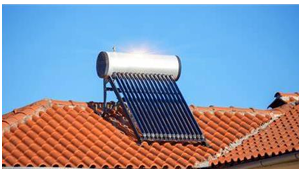
A. Function (Basa Rayo / What it Does):
- The main function of a solar water heater is to use sunlight energy to heat water (mvura inopisa).
- This hot water can then be used for bathing (kugeza), washing clothes, or other household needs, saving electricity often used by electric geysers (magiza).
B. Design (Magadzirirwo Acho / How it is Made):
A typical solar water heater system has two main parts: a solar collector and a storage tank.
- Solar Collector Panel (Panera reCollector):
- Design: This is usually a flat, shallow box mounted on the roof, facing the sun. Inside the box are:
- Black Pipes or Plate: A network of thin pipes (often copper) laid out on a black metal plate, OR the pipes themselves are painted black. Sometimes it's just a black surface with water channels.
- Glass Cover: A sheet of glass covers the top of the box.
- Insulation: The back and sides of the box are insulated (filled with material that stops heat escaping, like foam).
- How it Works:
- Sunlight passes through the glass cover.
- The black pipes/plate absorb the sunlight energy and get very hot.
- Water flowing through these pipes picks up the heat.
- The glass cover and insulation trap the heat inside the collector (greenhouse effect again) making it very efficient at heating the water.
- Design: This is usually a flat, shallow box mounted on the roof, facing the sun. Inside the box are:
- Insulated Storage Tank (Tangi reMvura Inopisa):
- Design: An insulated tank (like a regular geyser tank, but often without its own electric heater) to store the hot water. It's usually placed above the collector panel.
- How it Works: The tank is covered in thick insulation to keep the water hot for many hours, even after the sun goes down or on a cloudy day.
- Connecting Pipes and Circulation:
- Design: Pipes connect the bottom of the storage tank to the bottom inlet of the collector panel, and the top outlet of the collector panel back to the top part of the storage tank.
- How it Works (Thermosiphon Effect): This is clever! It often works without a pump.
- Cold water from the bottom of the tank flows down into the collector.
- As the water gets heated in the collector pipes, it becomes less dense (lighter).
- This lighter hot water naturally rises up the pipe from the collector into the top of the storage tank.
- The cooler, denser water at the bottom of the tank sinks down into the collector to be heated.
- This creates a natural circulation: Cold water down -> Gets heated -> Hot water rises -> Stores in tank -> Cool water sinks... and so on, as long as the sun is heating the collector.
In summary: A solar water heater uses a black collector panel covered with glass to absorb sunlight and heat water flowing through pipes. This hot water naturally rises and is stored in an insulated tank for later use.
Topic: TELECOMMUNICATION
Hello Students!
Long ago, sending messages far away was slow (like sending letters by runner or mail coach). Today, we can talk to someone on the other side of the world instantly! This sending of information over a distance is called Telecommunication. Let's see how some common methods work.
Communication Over a Distance (Kukurukura Uri Kure)
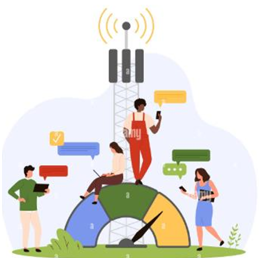
This just means sharing information (voice, messages, pictures) between people who are not in the same place. Two very common ways we do this today are:
A. Cell Phone (Nharembozha / Mobile Phone):
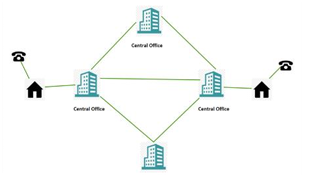
- Description: A small, portable device that allows you to make phone calls, send text messages (SMS), and often access the internet, almost anywhere. It works wirelessly (without needing a direct wire connection to the network while you use it).
- How it Works (Simple Idea): Your cell phone talks to a nearby tower (called a base station or mast) using invisible radio waves. This tower is connected to a larger network, which connects your call or message to the person you are trying to reach, even if they are very far away. (We'll look at this in more detail later).
B. Email (Tsamba dzeComputer/Phone):
- Description: Electronic mail. It allows you to send and receive written messages, pictures, and documents using computers, cell phones, or other devices connected to the Internet.
- How it Works (Simple Idea): When you send an email, your device connects to the internet (via Wi-Fi, cell phone data signal, or cable). The message travels through the internet network to the recipient's email server (a special computer). When the recipient checks their email, their device connects to the internet and downloads the message from their server. It's like an electronic post office system.
Media for Signal Transmission (Nzira dzekufambisa Signal)
For information (voice, data) to travel, it needs a pathway or a medium. Think of it like needing a road for a car to travel. (kuti message kana call yauri kusenda kutiisvike kwaurikuda kuti iyende panodiwa nzira yainofamba nyo, nzira iyoyo ndo inonzi medium. Paya patinoti hanty zvinofamba nemumhepo , yes its true, mhepo ndonzira yacho, nechirungu toti wireless)
Here are the main types of media used:
- Copper Wires / Cables:

- Examples: Old telephone lines, some types of internet connections (like ADSL).
- Description: Pairs of copper wires twisted together or bundled in a cable.
- Signal Type: Information travels as changing electrical signals (voltage or current).
- Air (Wireless / Radio Waves):
- Examples: Radio broadcasts, TV broadcasts, Cell phone signals, Wi-Fi, Bluetooth.
- Description: No physical path needed. The signal travels through the air (and even space).
- Signal Type: Information travels as electromagnetic waves (specifically, radio waves or microwaves). These are invisible waves similar to light waves but with different properties.
- Fibre Optic Cables (WayazveGirazi):
- Examples: Modern high-speed internet connections (like fibre-to-the-home), connections between network centres.
- Description: Cables containing very thin strands of pure glass or plastic.
- Signal Type: Information travels as pulses of light.
How Signals are Transmitted in Different Media
How does the information actually travel?
- In Copper Wires:
- A transmitter (like the part in your phone or modem) changes the information (voice, data) into a pattern of changing electrical voltage or current.
- This electrical signal travels along the copper wire like electricity flowing through any circuit.
- A receiver at the other end detects these changes in electricity and converts them back into the original information (voice, data).
- Limitation: Signals get weaker over distance (attenuation) and can be affected by electrical interference (noise).
- Through Air (Radio Waves):
- A transmitter (like in a radio station, cell phone tower, or your Wi-Fi router) takes the information signal and adds it onto a specific radio wave (this is called modulation).
- An antenna (kanyanga) sends this radio wave out into the air.
- The radio wave travels through the air in all directions (or focused in one direction).
- A receiver with its own antenna picks up the radio wave. It tunes into the specific wave (ignoring others) and separates the original information signal from the radio wave (demodulation).
- Limitation: Can be blocked by buildings, hills; different signals can interfere with each other; signal strength decreases with distance.
- In Fibre Optic Cables:
- A transmitter converts the information signal (usually already electrical) into pulses of light (using a tiny laser or LED).
- These light pulses travel down the thin glass fibre. They bounce off the inside walls of the fibre (total internal reflection) so they don't escape, even if the cable bends.
- A receiver (a light detector) at the other end sees these flashes of light and converts them back into an electrical signal, which is then converted back into the original information.
- Advantages: Very fast, carries huge amounts of information, doesn't lose signal strength quickly over long distances, not affected by electrical interference.
Operations of Cell Phones and Related Transmitters/Receivers
Let's put it all together for your cell phone (nharembozha):
- Your Cell Phone (Transmitter/Receiver):
- Microphone: Captures your voice and converts it into an electrical signal.
- Processing: The phone converts this electrical signal into a digital format and prepares it for radio transmission (modulation).
- Transmitter & Antenna: Sends this signal out as radio waves towards the nearest cell tower (base station).
- Antenna & Receiver: Picks up radio waves coming from the cell tower.
- Processing: Converts the received radio waves back into a digital signal, then into an electrical signal (demodulation).
- Speaker: Converts the electrical signal back into sound you can hear.
- Cell Tower / Base Station (Transmitter/Receiver):
- Antennas: Large antennas (kanyanga kari pamast) receive the weak radio signal from your phone and also transmit signals back to your phone.
- Receiver: Detects and processes the signal from your phone.
- Transmitter: Sends signals (voice, data) back to your phone.
- Connection to Network: The tower is connected (usually by high-speed fibre optic cables or microwave links) to the main mobile phone network's switching centre.
- The Network (How a Call Connects):
- When you make a call, your phone sends a signal to the nearest base station.
- The base station receives it and sends the information through the network to a switching centre.
- The switching centre finds the person you are calling. It figures out which base station is closest to them.
- The centre sends the signal to that base station.
- The receiving base station transmits the signal as radio waves to the other person's phone.
- Their phone receives the signal, and they hear your voice.
- Handoff: If you are moving (e.g., in a car), as you move away from one tower and closer to another, the network automatically switches your connection from the first tower to the second tower without interrupting your call. This is called "handoff".
Signal Strength: Your phone needs to be able to "talk" to a base station. That's why signal strength (shown by the bars on your phone) is weaker when you are far from a tower, inside buildings with thick walls, or in hilly areas where the radio waves are blocked.
Let's Summarise: Telecommunication
- Telecommunication is sending information over a distance (e.g., cell phones, email).
- Signals travel through different media: Copper Wires (electricity), Air (radio waves), Fibre Optics (light).
- Each medium uses transmitters to send the signal and receivers to get it.
- Cell phones work by sending and receiving radio waves to and from nearby base stations (towers/masts), which are connected to a larger network.
Topic: MAGNETISM & ELECTRICITY GENERATION, ELECTRICAL SAFETY & USE
Hello Students!
We've seen how forces and energy work. Now let's see how we generate the electricity (kuti togadzira sey magetsi) that powers our homes and towns. Magnetism plays a key role here! Then we'll learn how to handle electricity safely and manage its use.
Generating Electricity (Kugadzira Magetsi)
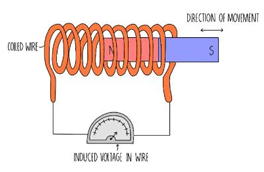
Most large-scale electricity generation relies on spinning a generator. A generator uses the principle of electromagnetic induction (discovered by Michael Faraday) – moving a magnet near a coil of wire (or moving a wire near a magnet) makes electricity flow in the wire. To make lots of electricity, you need to spin a big generator very fast. The challenge is finding the energy source to do the spinning!
A. Hydroelectric Power Generation (Magetsi eMvura)
- "Hydro" means water.
- Description: This method uses the energy of moving water, usually water falling from a height, to generate electricity. Big dams (madhamu) are often built for this.
- How it Works:
- Dam: A large dam is built across a river to hold back water and create a large lake or reservoir behind it. This stored water has potential energy (energy due to its height).
- Intake & Penstock: Water from the reservoir flows through large pipes called penstocks towards the power station at the bottom of the dam.
- Turbine: The falling water rushes through the penstocks and hits the blades of a large wheel called a turbine, causing it to spin rapidly. (The water's potential energy is converted to kinetic energy, which spins the turbine).
- Generator: The spinning turbine is connected by a shaft to a generator. As the turbine spins, it spins the generator.
- Electricity Production: The generator (using magnets and coils) converts the spinning (mechanical) energy into electrical energy.
- Transmission Lines: The electricity is then sent out through power lines (waya dzemagetsi) to homes and industries.
- (Panogadzirwa magetsi kukariba panoshandiswa method inzonzi hydro-electric power generation zvinorevakugadzira magetsi nemvura. But tinenge tisingachinji mvura kuita magets no, zvinofamba soo… apo pane zi wall paKariba rakavarira mvura kuti isabuda, kuvharirwa kwayakaitwa kunoita kuti kuzasi zasi kwe dam kuve ne pressure isingaiti zvekuti mvura nenge Ichida kutopaza wall. Saka kuzasi ikoko kwakabva kwaiswa mazi pipe ano collecter mvura iyoyo zvekuti vakangoivhurira inobuda ine speed,, ,saka kumberi kwema pipe iwayo keakabva kwaiswa mazinhu akaita kunge fan , zvekuti mvura ukavhurirwa inorova bapiro robva radzika pouya rimwe bapiro rorohwa robva radzika, zi fan racho robva ratanga kutenderera , parinenge richitenderera panenge pane magnet ichitotenndererawo, saka sezvatambotaura ukatenderedza magnet pama coils/mawaya akatenderedzwa panobva pagadzirwa magetsi akawandisa. Magetsi aya anobva ayenda achifambira mumazitambo, anobva ayenda ku power station ukwo kwaanobva awedzerwa uwandu hwawo nezvinhu zvinonzi Step Up Transformer, aya amunoti ma transformer, but aya anonzi step up which means ari kuwedzera kukwidza magetsi kuti awande. Awanda kudaro anobva afambiswamuma tambo aya atoona mudenga kuti ayende ku power station iri kudhuze nekumba kwenyu, ipapo anobva yendeswa kumba kwenyu, pane pa transformer ari mumaraini menyu aya, anonzi ma step down transformers, anoita basa rekudzora simba remagetsi nekuti magetsi anobva kukariba anenge ane power zvekuti akangopinda mumba menyu akadaro hamuna need yekubatidza TV kana fridge zvinenge zvatotsva kare. Saka ma step down transformers anodzora simba remagetsi kuti apinde mumba ari mashoma zvinoenderama nezvinhu zvatinoshandisa mumba )
- Example: Kariba Dam power station generates electricity using water from the Zambezi River stored in Lake Kariba.


B. Thermal Power Generation (Magetsi eKupisa)
- "Thermal" means related to heat.
- Description: This method uses heat to generate electricity. The heat usually comes from burning fuels.
- How it Works (Common method using steam):
- Fuel Burning: A fuel (like coal, oil, or natural gas) is burned in a large furnace or boiler.
- Boiler & Steam: The heat from the burning fuel boils water in pipes inside the boiler, turning it into very hot, high-pressure steam.
- Turbine: The high-pressure steam is directed through pipes to hit the blades of a steam turbine, causing it to spin very fast. (The heat energy is converted into kinetic energy of the steam, which spins the turbine).
- Generator: The spinning turbine is connected to a generator.
- Electricity Production: The generator converts the spinning energy into electrical energy.
- Cooling & Recycling: The steam, after passing through the turbine, is cooled down (often using water from a river or cooling towers) so it condenses back into water. This water is then pumped back to the boiler to be heated again, making the process continuous.
- Transmission Lines: Electricity is sent out through power lines.
- Example: Hwange Thermal Power Station generates electricity by burning coal.
- [magetsi ekuhwange anogadzirwa ne method inodzi thermal power generation iyo inoshandiswa heat kugadzira magetsi, thermal zvinoreva heat. Kuti tigadzire heat yakanyanyisa nehuni tingapedza Masango saka pane dombo re black rinocherwa pasi pasi, iroro dombo rikangotsva chete heat yarinobudisa yakawandisa zvekuti vana mazvikokota vakatoona ririro rakafanira panyaya dzekugadzira magetsi idzi. Process yacho inoitwa so: vanoits mazi tank esimbi pamusoro pemoto unenge uchigadzirwa ne coal, mumazi tank aya munenge mune mvura. Mvura yacho ino boiler fast zvekuti inobva yakadzira chiutsi chine pressure isingaiti chinobva chamanya nemumazi pipe chichitsvaga pekubuda napo fast fast,saka vakomana vakabva vaisa mazi turbine aya akaita se fan zvekuti anobva afuridzwa nechiutsi ichocho achibva atanga kutenderera, mukutenderera kwawo pane generator(maziwaya akagadzira zi circle ne zimagnet raka conector pa turbine)rinenge richitogadzira magetsi zvaro, robva ramaendesa ku power station, see how clever people are.Kune vanhu vanofunga.]
Electricity Safety & Use
Electricity is very useful, but it can also be dangerous if not handled properly.
A. Electrical Hazards (Ngozi dzeMagetsi)
- Electric Shock: If electricity flows through your body, it can cause pain, muscle contractions, burns, stop your heart, or even kill you. This happens if you touch live wires or faulty appliances while also touching the ground or something connected to the ground.
- Fires: Overheating wires (due to overloading sockets or faulty appliances) can melt insulation and start fires. Sparks from faulty connections can also ignite flammable materials.
- Burns: Touching very hot parts of electrical equipment or being close to electrical flashes/arcs can cause severe burns.
B. Safety Precautions (Kuzvidzivirira kuNgozi)
- Insulation: Wires are covered in plastic or rubber (rabha iya yakatenderedza wire patambo yemagets) to stop electricity from escaping and prevent shocks. Never use appliances with damaged or frayed wires/insulation.(usashandisa zvinhu zvemagetsi zvakadambuka tambo)
- Fuses and Circuit Breakers (maFyuz nemaBreaker): These are safety devices connected in the circuit. If too much current flows (which could cause overheating), the fuse wire melts or the circuit breaker switch flips off, stopping the flow of electricity automatically.
- Earthing (kuisa Waya yeEarth): Many appliances have a metal casing. An earth wire connects this metal casing directly to the ground (usually via the third pin in a plug). If a live wire accidentally touches the metal casing, the large current flows safely to the ground through the earth wire, blowing the fuse or tripping the breaker, instead of shocking someone who touches the appliance.
- Double Insulation: Some appliances (often with plastic casings, like hairdryers or phone chargers) are designed so that no metal parts can become live. They don't need an earth wire and often use a two-pin plug. Look for a symbol of a square inside another square.
- Avoid Water: Water conducts electricity! Never use electrical appliances with wet hands, near water (like in the bathroom sink or tub), or outdoors in the rain.
- Don't Overload Sockets: Plugging too many powerful appliances into one socket can cause the wires to overheat and start a fire. Use multi-socket adapters cautiously.
- Switch Off and Unplug: Switch off sockets before plugging in or unplugging appliances. Unplug appliances when not in use or during thunderstorms.
- Professional Help: Get qualified electricians (nyanzvi dzemagetsi) to do wiring or repair faulty appliances. Don't try to fix things yourself unless you are trained.
C. Wiring a Three-Pin Plug (Kubatanidza Plug reMapini Matatu)

Most appliances in Zimbabwe use a standard three-pin plug. Wiring it correctly is vital for safety.
- Parts:
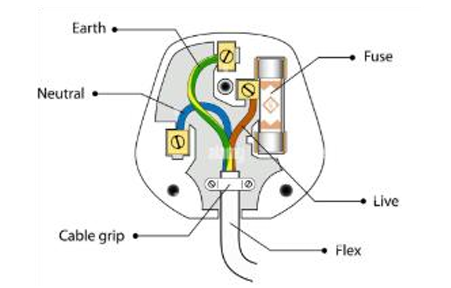
- Pins: Three metal pins (Live, Neutral, Earth). The Earth pin (top, thickest) is usually longest.
- Fuse: A small cartridge fuse located usually near the Live pin. It has a specific rating (e.g., 3A, 5A, 13A). (zvinenge zvakatonyorwa pachiri)
- Cable Grip: Holds the outer cable firmly so the wires inside don't get pulled out of their terminals.
- Terminals: Screws or clamps where the individual wires connect.
- Wire Colours (Standard UK/Zimbabwe colours):
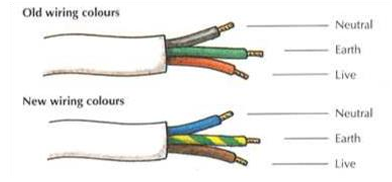
- BROWN wire connects to the LIVE terminal (usually marked L, connected to the fuse).
- BLUE wire connects to the NEUTRAL terminal (usually marked N).
- GREEN AND YELLOW striped wire connects to the EARTH terminal (usually marked E or with the earth symbol ⏚, connected to the top, longest pin).
- Procedure:
- Open the plug casing.
- Prepare the cable end: carefully remove the outer insulation, then strip a small amount of insulation from the end of each coloured wire. Twist the copper strands.
- Loosen the terminal screws.
- Connect each wire to the correct terminal (Brown to L, Blue to N, Green/Yellow to E). Ensure no stray strands of wire are sticking out. Tighten the screws firmly.
- Secure the outer cable firmly with the cable grip.
- Check the fuse rating is correct for the appliance.
- Replace the plug cover securely.
D. Use of a Two-Pin Plug:
- Some appliances (like phone chargers, radios, electric shavers) don't have metal casings that could become live, or they are double insulated.
- These appliances do not need an earth connection for safety.
- They use a two-pin plug which only connects to the Live and Neutral parts of the socket.
E. Uses of Electricity in the Home:
Electricity powers many things we use daily:
- Lighting: Light bulbs (maglobhu).
- Heating: Stoves (chitofu), heaters (hita), electric kettles (ketera), electric geysers (giza).
- Cooling: Refrigerators (firiji), fans.
- Entertainment: Televisions (TV)(chivhitivhiti), radios(dzimudzangara), computers, music players.
- Communication: Charging phones (nharembozha), running internet routers.
- Other Appliances: Irons (aini), washing machines, vacuum cleaners, kitchen mixers.
F. Calculating Cost of Electricity (Kuverenga Mari yeMagetsi):

- Electricity usage is measured in Units or kilowatt-hours (kWh).
- 1 kWh means using 1 kilowatt (1000 Watts) of power for 1 hour. (1kWh k-kilo(kilozvoreva 1000) W-Watt h- hour)
- (Units used = Power in kW × Time in hours)
- The electricity company (like ZESA) charges a certain amount of money for each unit (kWh) used. This is the cost per unit.
- Formula:
Total Cost = Units Used (kWh) × Cost per Unit - Example: A 100 Watt light bulb is left on for 10 hours. ZESA charges $50 per kWh. What is the cost?
- Convert Power to kW: 100 W = 100 / 1000 = 0.1 kW
- Calculate Units Used: Units = Power (kW) × Time (h) = 0.1 kW × 10 h = 1 kWh
- Calculate Cost: Cost = Units Used × Cost per Unit = 1 kWh × $50/kWh = $50
G. Methods of Saving Electricity (Nzira dzekuChengetedza Magetsi):
Saving electricity helps reduce bills and is good for the environment.
- Switch Off: Turn off lights, TVs, radios, computers when not using them. Don't leave things on standby.
- Use Energy-Saving Bulbs: Replace old incandescent bulbs with LEDs or CFLs (compact fluorescent lamps), which use much less electricity for the same amount of light.
- Efficient Appliances: When buying new appliances (like fridges), look for ones with good energy ratings (energy efficient).
- Heating/Cooling Wisely: Don't heat or cool rooms unnecessarily. Use fans instead of air conditioning if possible. Only boil the amount of water you need in a kettle. Cook efficiently (e.g., use lids on pots).
- Ironing: Iron clothes in larger batches rather than one item at a time.
- Fix Leaks: Fix dripping hot water taps (saves energy used by the geyser).
- Use Solar: Use solar water heaters or solar lights where possible.
H. Solar Photovoltaic (PV) Systems (Magetsi eSolar Panel):
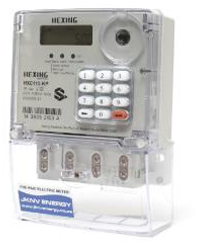
- What they are: Systems that convert sunlight directly into electricity using solar panels. "Photo" means light, "voltaic" means electricity.
- How they work:
- Solar Panels: Made of many solar cells (usually silicon). When sunlight hits these cells, it excites electrons, causing electricity (Direct Current - DC) to flow.
- (Charge Controller): Manages the electricity from the panels to charge batteries properly and prevent overcharging.
- (Batteries): Store the DC electricity so it can be used when the sun isn't shining (at night or on cloudy days).
- (Inverter): Converts the DC electricity stored in the batteries into Alternating Current (AC) electricity, which is the type most household appliances use.
- Uses:
- Powering homes, schools, clinics, especially in areas off the main electricity grid (kunzvimbo dzisina tambo dzemagetsi).
- Running lights, radios, TVs, charging phones.
- Powering water pumps for irrigation or drinking water.
- Small systems for streetlights or security lights.
- Can supplement grid power to reduce bills.
Let's Summarise: Magnetism, Electricity & Safety
- Hydroelectric power uses falling water to spin turbines and generators. Thermal power uses heat (usually from burning fuel) to make steam to spin turbines and generators.
- Electricity can cause shock, fire, and burns. Stay safe using insulation, fuses/breakers, earthing, avoiding water, and getting professional help.
- A 3-pin plug needs correct wiring: Brown-Live, Blue-Neutral, Green/Yellow-Earth. 2-pin plugs are for double-insulated items.
- Electricity powers lights, heating, cooking, entertainment etc. at home.
- Cost of electricity = Units (kWh) used × Cost per unit.
- Save electricity by switching things off, using efficient bulbs/appliances, and using alternatives like solar.
- Solar PV systems use panels to turn sunlight directly into electricity, often stored in batteries, useful for off-grid power.
